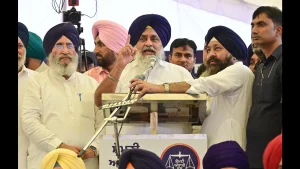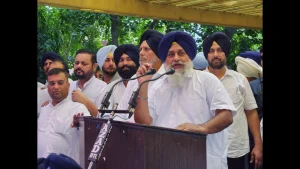The political landscape of Punjab witnessed an unexpected turn when the Aam Aadmi Party’s controversial land pooling policy became the catalyst for a remarkable SAD political revival. What appeared to be another policy implementation by the AAP-led government inadvertently provided the crisis-hit Shiromani Akali Dal with a golden opportunity to reconnect with its traditional support base and re-establish its presence in Punjab’s political arena.
The scrapped land pooling policy emerged as a blessing in disguise for the struggling Shiromani Akali Dal, marking the beginning of a significant SAD political revival. This policy, which was designed to facilitate urban development and infrastructure projects, struck at the very heart of rural Punjab’s concerns about land ownership and agricultural sustainability. The controversy surrounding the policy created a perfect storm for the SAD to leverage its historical connection with the farming community.
 The timing of this policy implementation could not have been more fortuitous for the party’s SAD political revival efforts. As the AAP government faced mounting criticism from rural constituencies, the Shiromani Akali Dal found itself in a unique position to champion the cause of land rights and agricultural preservation. This issue resonated deeply with the rural peasantry, who viewed the land pooling policy as a direct threat to their traditional way of life and economic security.
The timing of this policy implementation could not have been more fortuitous for the party’s SAD political revival efforts. As the AAP government faced mounting criticism from rural constituencies, the Shiromani Akali Dal found itself in a unique position to champion the cause of land rights and agricultural preservation. This issue resonated deeply with the rural peasantry, who viewed the land pooling policy as a direct threat to their traditional way of life and economic security.
Also Read: SAD and its relation with The Punjab Land Reforms Act, 1972
Does SAD’s political revival have anything to do with land resources?
The rural peasantry has historically formed the backbone of SAD’s electoral success, and the party’s SAD political revival strategy centred on rebuilding these crucial relationships. The land pooling policy controversy provided an authentic platform for the party to demonstrate its commitment to protecting farmer interests and preserving agricultural lands from what many perceived as urban encroachment.
This reconnection was not merely opportunistic but reflected the party’s deep-rooted understanding of rural concerns. The SAD political revival gained momentum as party leaders actively engaged with farming communities, addressing their fears about land acquisition and highlighting the potential negative impacts of the AAP government’s policies on agricultural livelihoods.
The party’s messaging during this period emphasised its role as the guardian of rural interests, positioning itself as the primary opposition to policies that threatened traditional agricultural practices. This approach proved instrumental in the ongoing SAD political revival, as it allowed the party to distinguish itself from other political entities and establish a clear narrative of rural advocacy.
To understand the significance of the current SAD political revival, it is essential to examine the party’s recent electoral journey. The Shiromani Akali Dal experienced considerable success when it formed two consecutive governments in 2007 and 2012, demonstrating its ability to maintain power through effective rural outreach and agricultural policy advocacy.
 However, the party’s fortunes took a dramatic downturn in subsequent elections. The decline was most evident in the 2017 Punjab Vidhan Sabha elections, where the SAD secured 15 seats out of 117, a respectable showing that nonetheless indicated growing challenges in maintaining its traditional voter base.
However, the party’s fortunes took a dramatic downturn in subsequent elections. The decline was most evident in the 2017 Punjab Vidhan Sabha elections, where the SAD secured 15 seats out of 117, a respectable showing that nonetheless indicated growing challenges in maintaining its traditional voter base.
The situation deteriorated further in the 2022 elections, where the party’s tally plummeted to just three seats. This dramatic reduction highlighted the urgent need for a comprehensive SAD political revival strategy that could address the party’s declining influence and reconnect with its core constituencies.
The land pooling policy controversy fundamentally altered Punjab’s political dynamics, creating opportunities for opposition parties to challenge the AAP government’s rural policies. The SAD political revival benefited significantly from this shift, as the party could position itself as an experienced alternative with deep roots in agricultural advocacy.
This transformation was particularly significant given the AAP’s initial popularity in Punjab. The party had swept to power with promises of change and clean governance, but the land pooling policy revealed potential vulnerabilities in its approach to rural issues. The controversy provided the perfect opening for the SAD political revival to gain traction among disillusioned rural voters.
The policy’s eventual scrapping vindicated the opposition’s criticism and demonstrated the power of sustained political pressure. For SAD, this outcome represented a validation of its stance and contributed to the credibility of its SAD political revival narrative.
The success of the SAD political revival through the land pooling policy issue demonstrates the enduring importance of agricultural concerns in Punjab politics. The party’s ability to capitalise on this opportunity reflects its institutional memory and understanding of rural dynamics, factors that proved crucial in rebuilding its political relevance.
Moving forward, the SAD political revival faces the challenge of translating this renewed visibility into sustained electoral success. The party must build upon its advocacy around the land pooling policy to develop a comprehensive platform that addresses the evolving needs of rural Punjab while maintaining its traditional support base.


As the party continues its journey of political renewal, the lessons learned from this SAD political revival will undoubtedly influence its future strategies and approach to rural constituency building. The transformation from a three-seat party to a reinvigorated political force demonstrates the potential for rapid change in Punjab’s ever-evolving political environment.

